Reasons Why People Take Drugs
VerifiedAdded on 2022/11/14
|13
|3946
|105
AI Summary
This article explores the various reasons why people take drugs and the impact it has on society. It critically analyses the sociological perspectives, normalisation thesis, polydrug use, economic crisis, illicit drugs, hospital admission, and more. The article also provides statistical data on the use of drugs among adults and children in the UK.
Contribute Materials
Your contribution can guide someone’s learning journey. Share your
documents today.
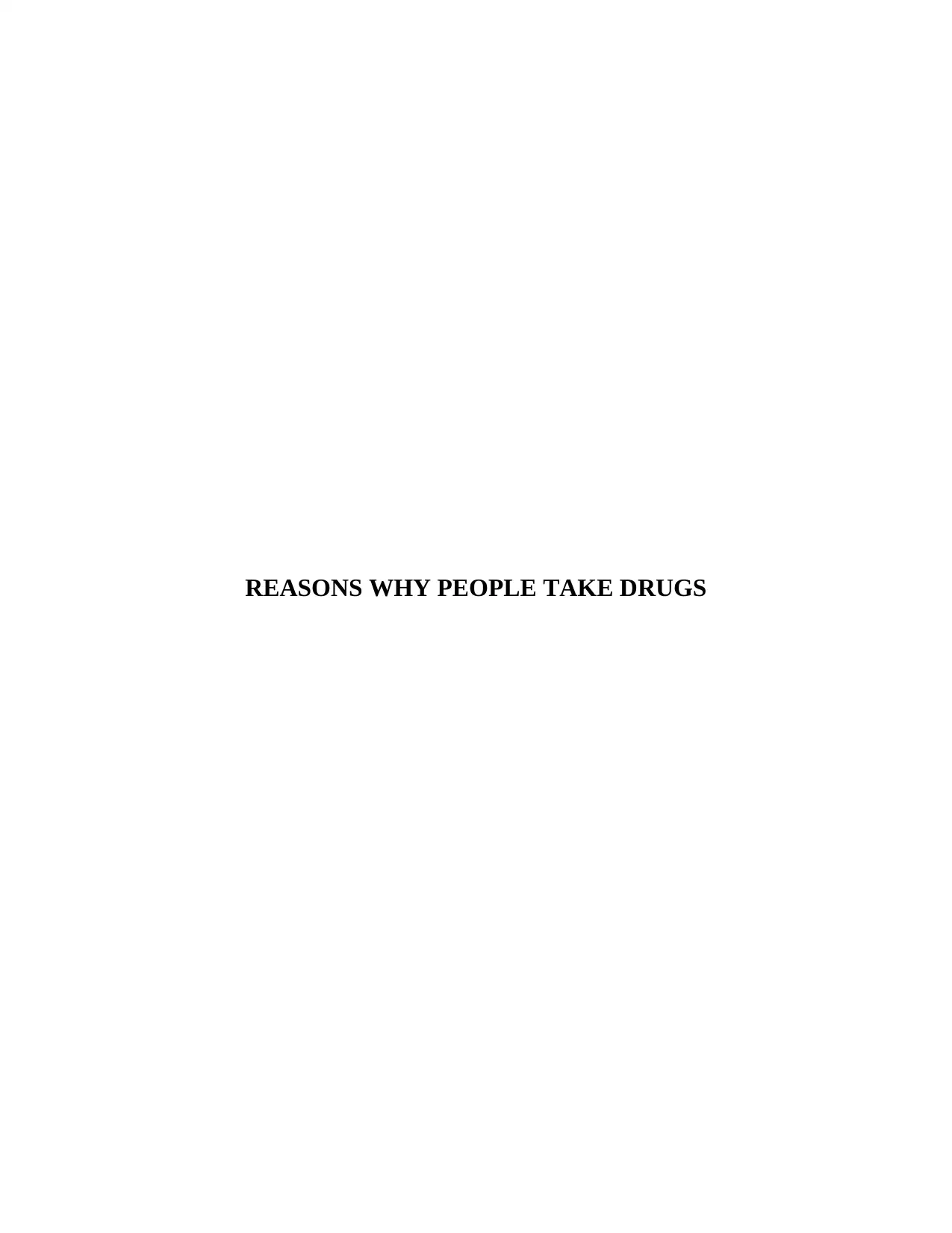
REASONS WHY PEOPLE TAKE DRUGS
Secure Best Marks with AI Grader
Need help grading? Try our AI Grader for instant feedback on your assignments.
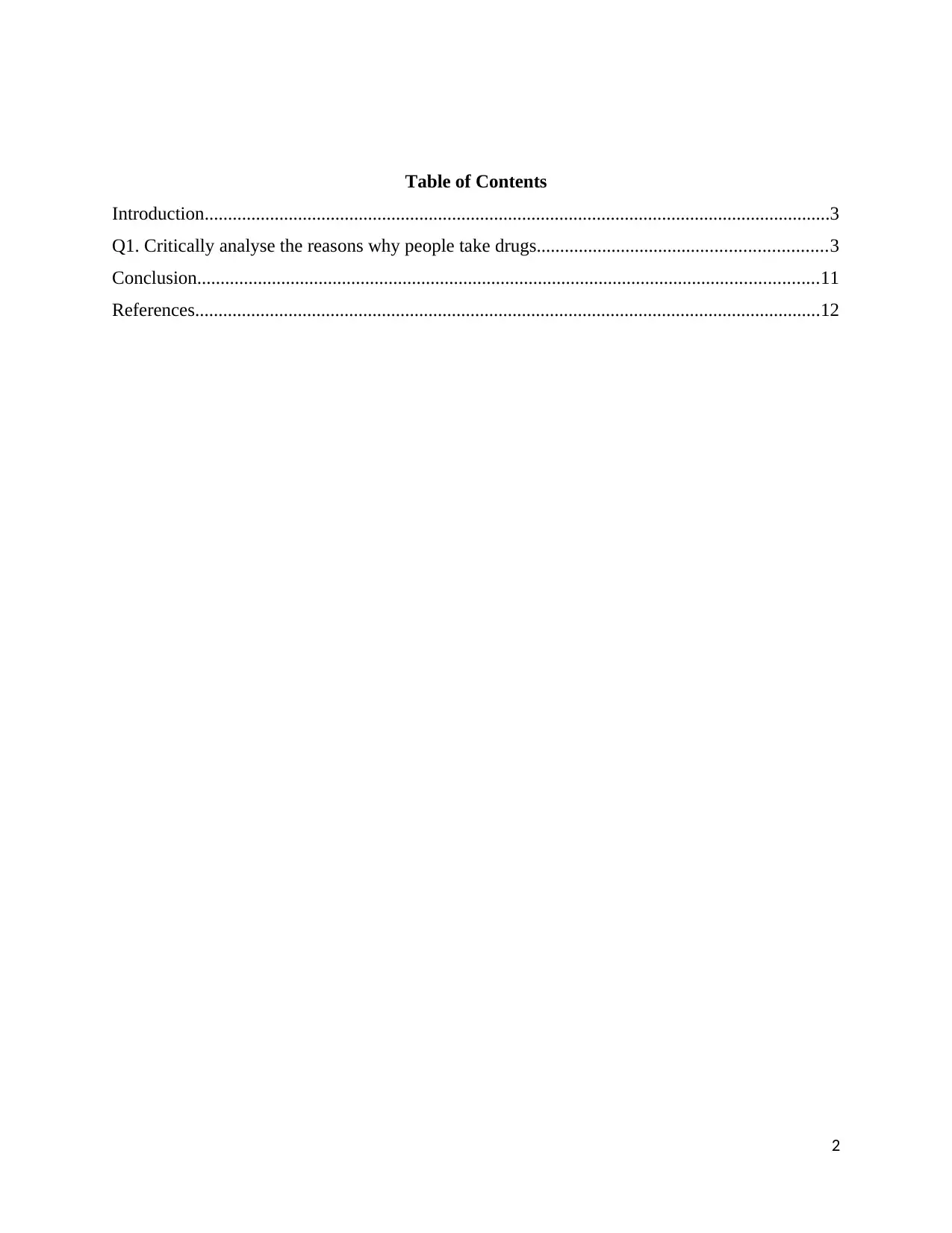
Table of Contents
Introduction......................................................................................................................................3
Q1. Critically analyse the reasons why people take drugs..............................................................3
Conclusion.....................................................................................................................................11
References......................................................................................................................................12
2
Introduction......................................................................................................................................3
Q1. Critically analyse the reasons why people take drugs..............................................................3
Conclusion.....................................................................................................................................11
References......................................................................................................................................12
2
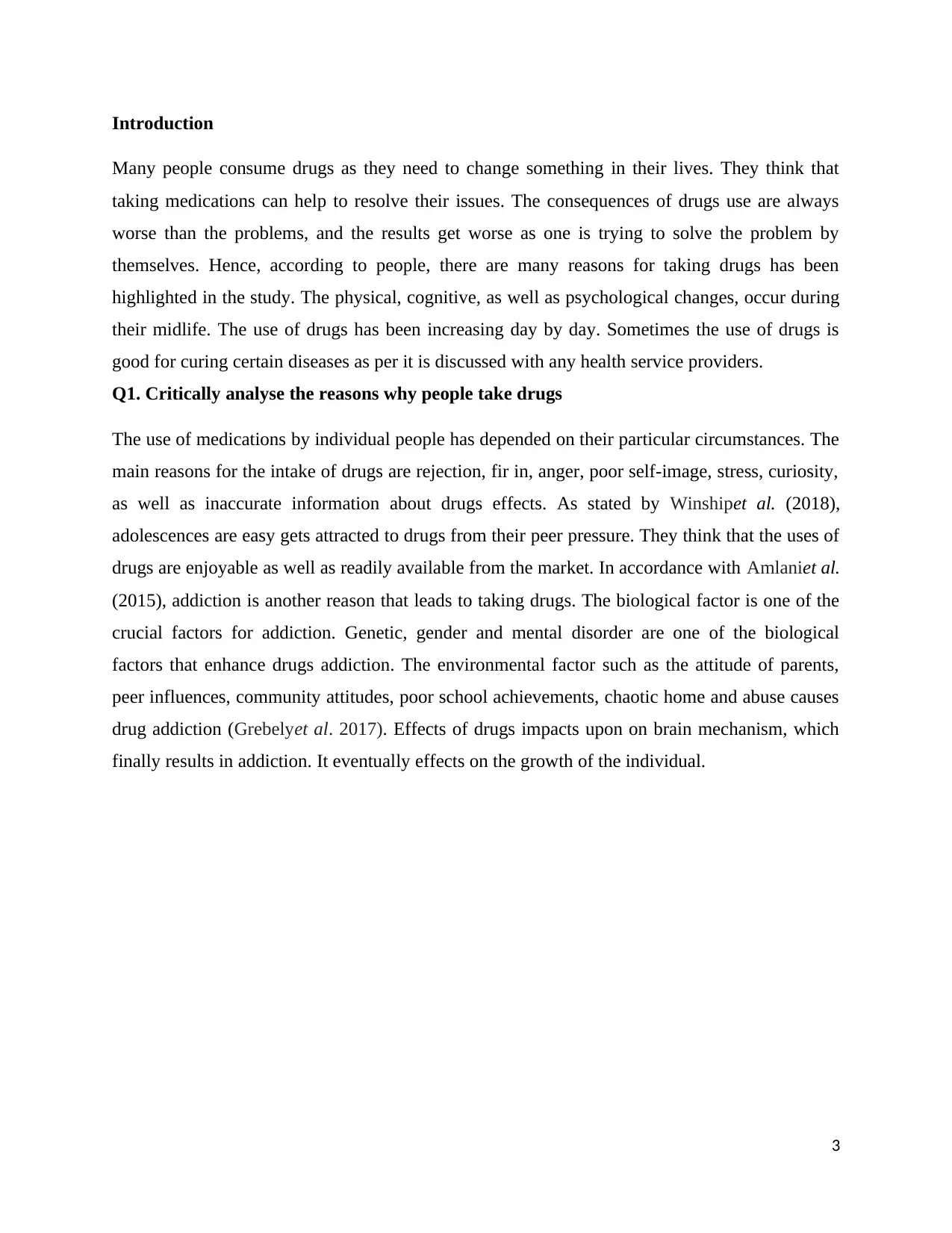
Introduction
Many people consume drugs as they need to change something in their lives. They think that
taking medications can help to resolve their issues. The consequences of drugs use are always
worse than the problems, and the results get worse as one is trying to solve the problem by
themselves. Hence, according to people, there are many reasons for taking drugs has been
highlighted in the study. The physical, cognitive, as well as psychological changes, occur during
their midlife. The use of drugs has been increasing day by day. Sometimes the use of drugs is
good for curing certain diseases as per it is discussed with any health service providers.
Q1. Critically analyse the reasons why people take drugs
The use of medications by individual people has depended on their particular circumstances. The
main reasons for the intake of drugs are rejection, fir in, anger, poor self-image, stress, curiosity,
as well as inaccurate information about drugs effects. As stated by Winshipet al. (2018),
adolescences are easy gets attracted to drugs from their peer pressure. They think that the uses of
drugs are enjoyable as well as readily available from the market. In accordance with Amlaniet al.
(2015), addiction is another reason that leads to taking drugs. The biological factor is one of the
crucial factors for addiction. Genetic, gender and mental disorder are one of the biological
factors that enhance drugs addiction. The environmental factor such as the attitude of parents,
peer influences, community attitudes, poor school achievements, chaotic home and abuse causes
drug addiction (Grebelyet al. 2017). Effects of drugs impacts upon on brain mechanism, which
finally results in addiction. It eventually effects on the growth of the individual.
3
Many people consume drugs as they need to change something in their lives. They think that
taking medications can help to resolve their issues. The consequences of drugs use are always
worse than the problems, and the results get worse as one is trying to solve the problem by
themselves. Hence, according to people, there are many reasons for taking drugs has been
highlighted in the study. The physical, cognitive, as well as psychological changes, occur during
their midlife. The use of drugs has been increasing day by day. Sometimes the use of drugs is
good for curing certain diseases as per it is discussed with any health service providers.
Q1. Critically analyse the reasons why people take drugs
The use of medications by individual people has depended on their particular circumstances. The
main reasons for the intake of drugs are rejection, fir in, anger, poor self-image, stress, curiosity,
as well as inaccurate information about drugs effects. As stated by Winshipet al. (2018),
adolescences are easy gets attracted to drugs from their peer pressure. They think that the uses of
drugs are enjoyable as well as readily available from the market. In accordance with Amlaniet al.
(2015), addiction is another reason that leads to taking drugs. The biological factor is one of the
crucial factors for addiction. Genetic, gender and mental disorder are one of the biological
factors that enhance drugs addiction. The environmental factor such as the attitude of parents,
peer influences, community attitudes, poor school achievements, chaotic home and abuse causes
drug addiction (Grebelyet al. 2017). Effects of drugs impacts upon on brain mechanism, which
finally results in addiction. It eventually effects on the growth of the individual.
3
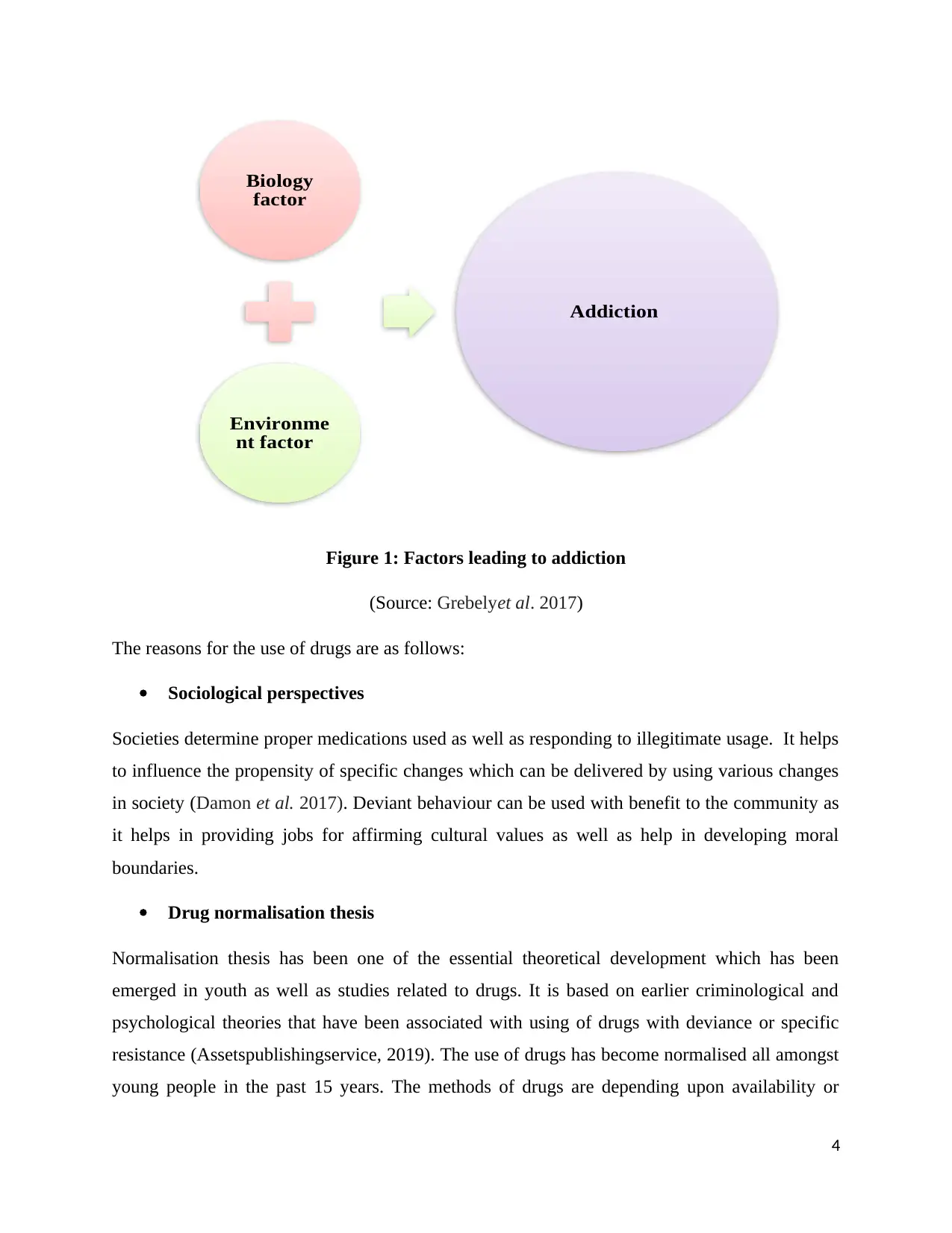
Figure 1: Factors leading to addiction
(Source: Grebelyet al. 2017)
The reasons for the use of drugs are as follows:
Sociological perspectives
Societies determine proper medications used as well as responding to illegitimate usage. It helps
to influence the propensity of specific changes which can be delivered by using various changes
in society (Damon et al. 2017). Deviant behaviour can be used with benefit to the community as
it helps in providing jobs for affirming cultural values as well as help in developing moral
boundaries.
Drug normalisation thesis
Normalisation thesis has been one of the essential theoretical development which has been
emerged in youth as well as studies related to drugs. It is based on earlier criminological and
psychological theories that have been associated with using of drugs with deviance or specific
resistance (Assetspublishingservice, 2019). The use of drugs has become normalised all amongst
young people in the past 15 years. The methods of drugs are depending upon availability or
4
Biology
factor
Environme
nt factor
Addiction
(Source: Grebelyet al. 2017)
The reasons for the use of drugs are as follows:
Sociological perspectives
Societies determine proper medications used as well as responding to illegitimate usage. It helps
to influence the propensity of specific changes which can be delivered by using various changes
in society (Damon et al. 2017). Deviant behaviour can be used with benefit to the community as
it helps in providing jobs for affirming cultural values as well as help in developing moral
boundaries.
Drug normalisation thesis
Normalisation thesis has been one of the essential theoretical development which has been
emerged in youth as well as studies related to drugs. It is based on earlier criminological and
psychological theories that have been associated with using of drugs with deviance or specific
resistance (Assetspublishingservice, 2019). The use of drugs has become normalised all amongst
young people in the past 15 years. The methods of drugs are depending upon availability or
4
Biology
factor
Environme
nt factor
Addiction
Secure Best Marks with AI Grader
Need help grading? Try our AI Grader for instant feedback on your assignments.
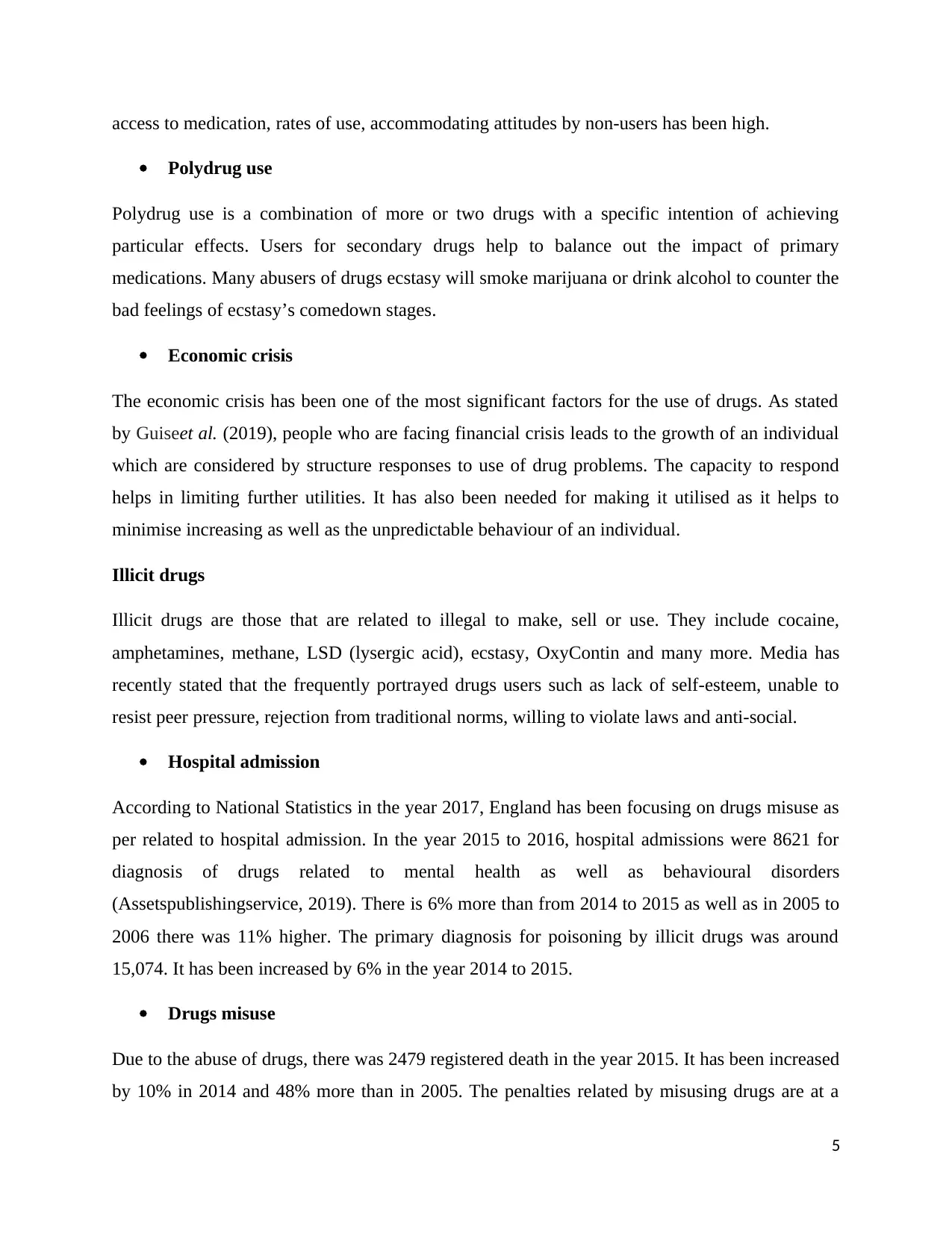
access to medication, rates of use, accommodating attitudes by non-users has been high.
Polydrug use
Polydrug use is a combination of more or two drugs with a specific intention of achieving
particular effects. Users for secondary drugs help to balance out the impact of primary
medications. Many abusers of drugs ecstasy will smoke marijuana or drink alcohol to counter the
bad feelings of ecstasy’s comedown stages.
Economic crisis
The economic crisis has been one of the most significant factors for the use of drugs. As stated
by Guiseet al. (2019), people who are facing financial crisis leads to the growth of an individual
which are considered by structure responses to use of drug problems. The capacity to respond
helps in limiting further utilities. It has also been needed for making it utilised as it helps to
minimise increasing as well as the unpredictable behaviour of an individual.
Illicit drugs
Illicit drugs are those that are related to illegal to make, sell or use. They include cocaine,
amphetamines, methane, LSD (lysergic acid), ecstasy, OxyContin and many more. Media has
recently stated that the frequently portrayed drugs users such as lack of self-esteem, unable to
resist peer pressure, rejection from traditional norms, willing to violate laws and anti-social.
Hospital admission
According to National Statistics in the year 2017, England has been focusing on drugs misuse as
per related to hospital admission. In the year 2015 to 2016, hospital admissions were 8621 for
diagnosis of drugs related to mental health as well as behavioural disorders
(Assetspublishingservice, 2019). There is 6% more than from 2014 to 2015 as well as in 2005 to
2006 there was 11% higher. The primary diagnosis for poisoning by illicit drugs was around
15,074. It has been increased by 6% in the year 2014 to 2015.
Drugs misuse
Due to the abuse of drugs, there was 2479 registered death in the year 2015. It has been increased
by 10% in 2014 and 48% more than in 2005. The penalties related by misusing drugs are at a
5
Polydrug use
Polydrug use is a combination of more or two drugs with a specific intention of achieving
particular effects. Users for secondary drugs help to balance out the impact of primary
medications. Many abusers of drugs ecstasy will smoke marijuana or drink alcohol to counter the
bad feelings of ecstasy’s comedown stages.
Economic crisis
The economic crisis has been one of the most significant factors for the use of drugs. As stated
by Guiseet al. (2019), people who are facing financial crisis leads to the growth of an individual
which are considered by structure responses to use of drug problems. The capacity to respond
helps in limiting further utilities. It has also been needed for making it utilised as it helps to
minimise increasing as well as the unpredictable behaviour of an individual.
Illicit drugs
Illicit drugs are those that are related to illegal to make, sell or use. They include cocaine,
amphetamines, methane, LSD (lysergic acid), ecstasy, OxyContin and many more. Media has
recently stated that the frequently portrayed drugs users such as lack of self-esteem, unable to
resist peer pressure, rejection from traditional norms, willing to violate laws and anti-social.
Hospital admission
According to National Statistics in the year 2017, England has been focusing on drugs misuse as
per related to hospital admission. In the year 2015 to 2016, hospital admissions were 8621 for
diagnosis of drugs related to mental health as well as behavioural disorders
(Assetspublishingservice, 2019). There is 6% more than from 2014 to 2015 as well as in 2005 to
2006 there was 11% higher. The primary diagnosis for poisoning by illicit drugs was around
15,074. It has been increased by 6% in the year 2014 to 2015.
Drugs misuse
Due to the abuse of drugs, there was 2479 registered death in the year 2015. It has been increased
by 10% in 2014 and 48% more than in 2005. The penalties related by misusing drugs are at a
5
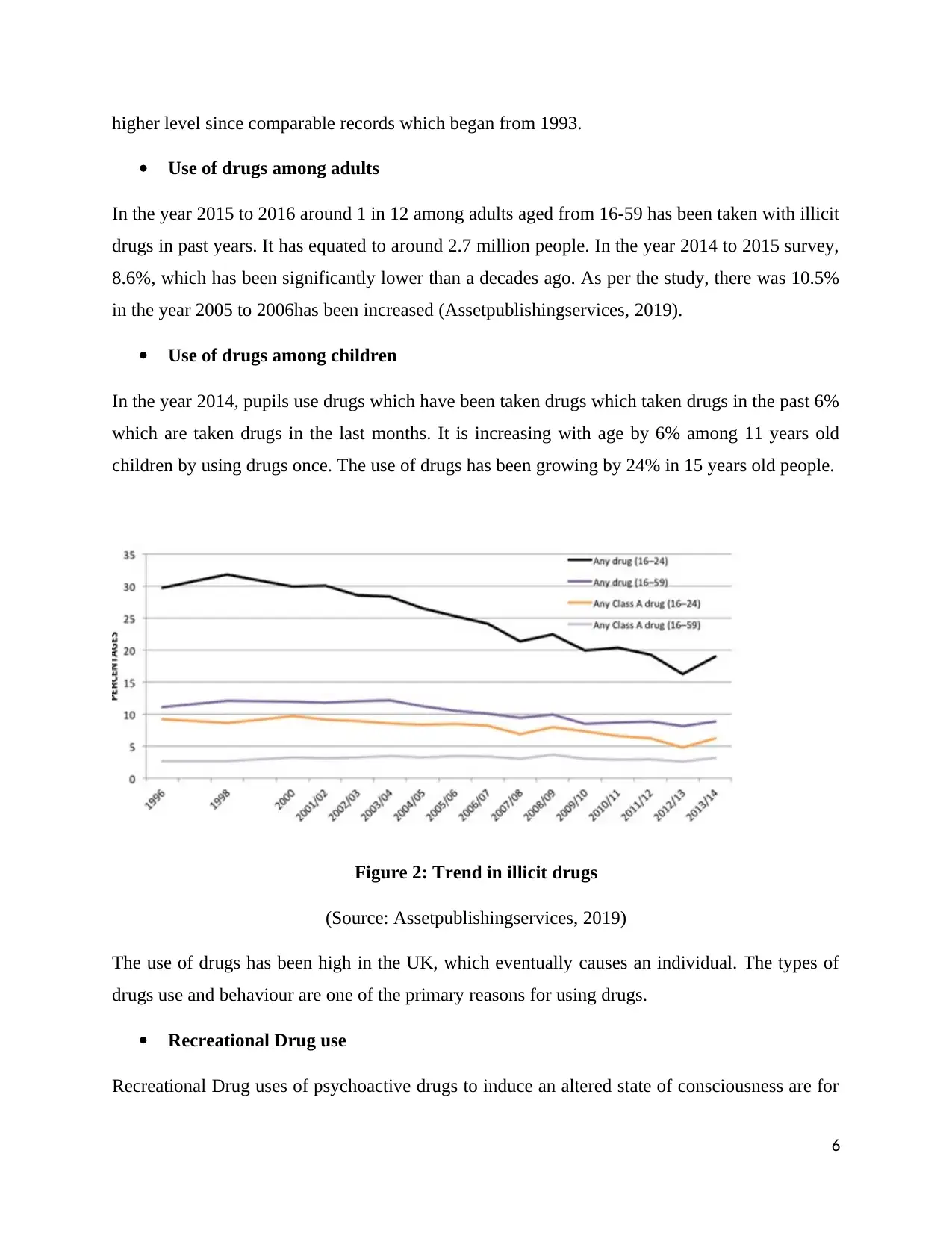
higher level since comparable records which began from 1993.
Use of drugs among adults
In the year 2015 to 2016 around 1 in 12 among adults aged from 16-59 has been taken with illicit
drugs in past years. It has equated to around 2.7 million people. In the year 2014 to 2015 survey,
8.6%, which has been significantly lower than a decades ago. As per the study, there was 10.5%
in the year 2005 to 2006has been increased (Assetpublishingservices, 2019).
Use of drugs among children
In the year 2014, pupils use drugs which have been taken drugs which taken drugs in the past 6%
which are taken drugs in the last months. It is increasing with age by 6% among 11 years old
children by using drugs once. The use of drugs has been growing by 24% in 15 years old people.
Figure 2: Trend in illicit drugs
(Source: Assetpublishingservices, 2019)
The use of drugs has been high in the UK, which eventually causes an individual. The types of
drugs use and behaviour are one of the primary reasons for using drugs.
Recreational Drug use
Recreational Drug uses of psychoactive drugs to induce an altered state of consciousness are for
6
Use of drugs among adults
In the year 2015 to 2016 around 1 in 12 among adults aged from 16-59 has been taken with illicit
drugs in past years. It has equated to around 2.7 million people. In the year 2014 to 2015 survey,
8.6%, which has been significantly lower than a decades ago. As per the study, there was 10.5%
in the year 2005 to 2006has been increased (Assetpublishingservices, 2019).
Use of drugs among children
In the year 2014, pupils use drugs which have been taken drugs which taken drugs in the past 6%
which are taken drugs in the last months. It is increasing with age by 6% among 11 years old
children by using drugs once. The use of drugs has been growing by 24% in 15 years old people.
Figure 2: Trend in illicit drugs
(Source: Assetpublishingservices, 2019)
The use of drugs has been high in the UK, which eventually causes an individual. The types of
drugs use and behaviour are one of the primary reasons for using drugs.
Recreational Drug use
Recreational Drug uses of psychoactive drugs to induce an altered state of consciousness are for
6
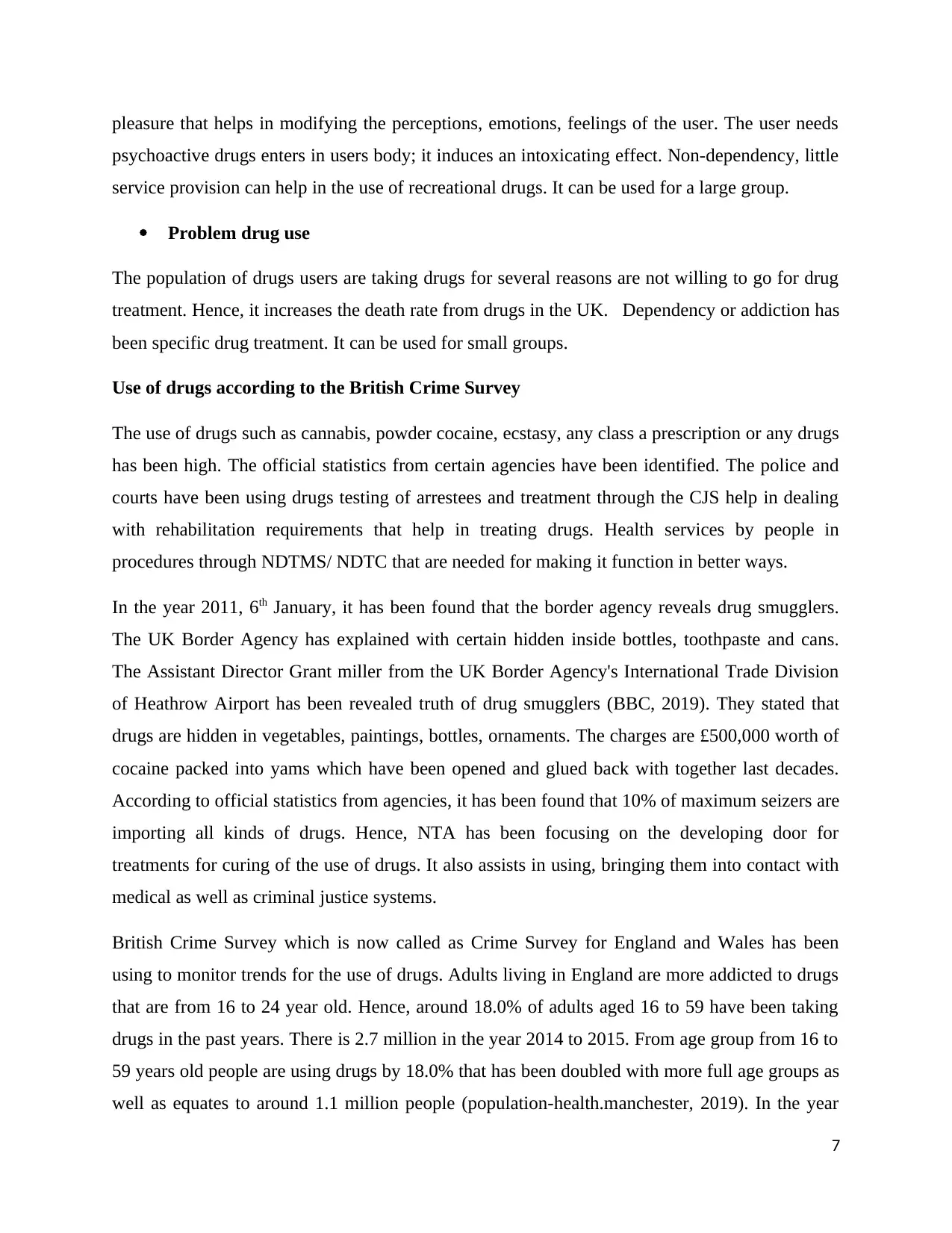
pleasure that helps in modifying the perceptions, emotions, feelings of the user. The user needs
psychoactive drugs enters in users body; it induces an intoxicating effect. Non-dependency, little
service provision can help in the use of recreational drugs. It can be used for a large group.
Problem drug use
The population of drugs users are taking drugs for several reasons are not willing to go for drug
treatment. Hence, it increases the death rate from drugs in the UK. Dependency or addiction has
been specific drug treatment. It can be used for small groups.
Use of drugs according to the British Crime Survey
The use of drugs such as cannabis, powder cocaine, ecstasy, any class a prescription or any drugs
has been high. The official statistics from certain agencies have been identified. The police and
courts have been using drugs testing of arrestees and treatment through the CJS help in dealing
with rehabilitation requirements that help in treating drugs. Health services by people in
procedures through NDTMS/ NDTC that are needed for making it function in better ways.
In the year 2011, 6th January, it has been found that the border agency reveals drug smugglers.
The UK Border Agency has explained with certain hidden inside bottles, toothpaste and cans.
The Assistant Director Grant miller from the UK Border Agency's International Trade Division
of Heathrow Airport has been revealed truth of drug smugglers (BBC, 2019). They stated that
drugs are hidden in vegetables, paintings, bottles, ornaments. The charges are £500,000 worth of
cocaine packed into yams which have been opened and glued back with together last decades.
According to official statistics from agencies, it has been found that 10% of maximum seizers are
importing all kinds of drugs. Hence, NTA has been focusing on the developing door for
treatments for curing of the use of drugs. It also assists in using, bringing them into contact with
medical as well as criminal justice systems.
British Crime Survey which is now called as Crime Survey for England and Wales has been
using to monitor trends for the use of drugs. Adults living in England are more addicted to drugs
that are from 16 to 24 year old. Hence, around 18.0% of adults aged 16 to 59 have been taking
drugs in the past years. There is 2.7 million in the year 2014 to 2015. From age group from 16 to
59 years old people are using drugs by 18.0% that has been doubled with more full age groups as
well as equates to around 1.1 million people (population-health.manchester, 2019). In the year
7
psychoactive drugs enters in users body; it induces an intoxicating effect. Non-dependency, little
service provision can help in the use of recreational drugs. It can be used for a large group.
Problem drug use
The population of drugs users are taking drugs for several reasons are not willing to go for drug
treatment. Hence, it increases the death rate from drugs in the UK. Dependency or addiction has
been specific drug treatment. It can be used for small groups.
Use of drugs according to the British Crime Survey
The use of drugs such as cannabis, powder cocaine, ecstasy, any class a prescription or any drugs
has been high. The official statistics from certain agencies have been identified. The police and
courts have been using drugs testing of arrestees and treatment through the CJS help in dealing
with rehabilitation requirements that help in treating drugs. Health services by people in
procedures through NDTMS/ NDTC that are needed for making it function in better ways.
In the year 2011, 6th January, it has been found that the border agency reveals drug smugglers.
The UK Border Agency has explained with certain hidden inside bottles, toothpaste and cans.
The Assistant Director Grant miller from the UK Border Agency's International Trade Division
of Heathrow Airport has been revealed truth of drug smugglers (BBC, 2019). They stated that
drugs are hidden in vegetables, paintings, bottles, ornaments. The charges are £500,000 worth of
cocaine packed into yams which have been opened and glued back with together last decades.
According to official statistics from agencies, it has been found that 10% of maximum seizers are
importing all kinds of drugs. Hence, NTA has been focusing on the developing door for
treatments for curing of the use of drugs. It also assists in using, bringing them into contact with
medical as well as criminal justice systems.
British Crime Survey which is now called as Crime Survey for England and Wales has been
using to monitor trends for the use of drugs. Adults living in England are more addicted to drugs
that are from 16 to 24 year old. Hence, around 18.0% of adults aged 16 to 59 have been taking
drugs in the past years. There is 2.7 million in the year 2014 to 2015. From age group from 16 to
59 years old people are using drugs by 18.0% that has been doubled with more full age groups as
well as equates to around 1.1 million people (population-health.manchester, 2019). In the year
7
Paraphrase This Document
Need a fresh take? Get an instant paraphrase of this document with our AI Paraphraser
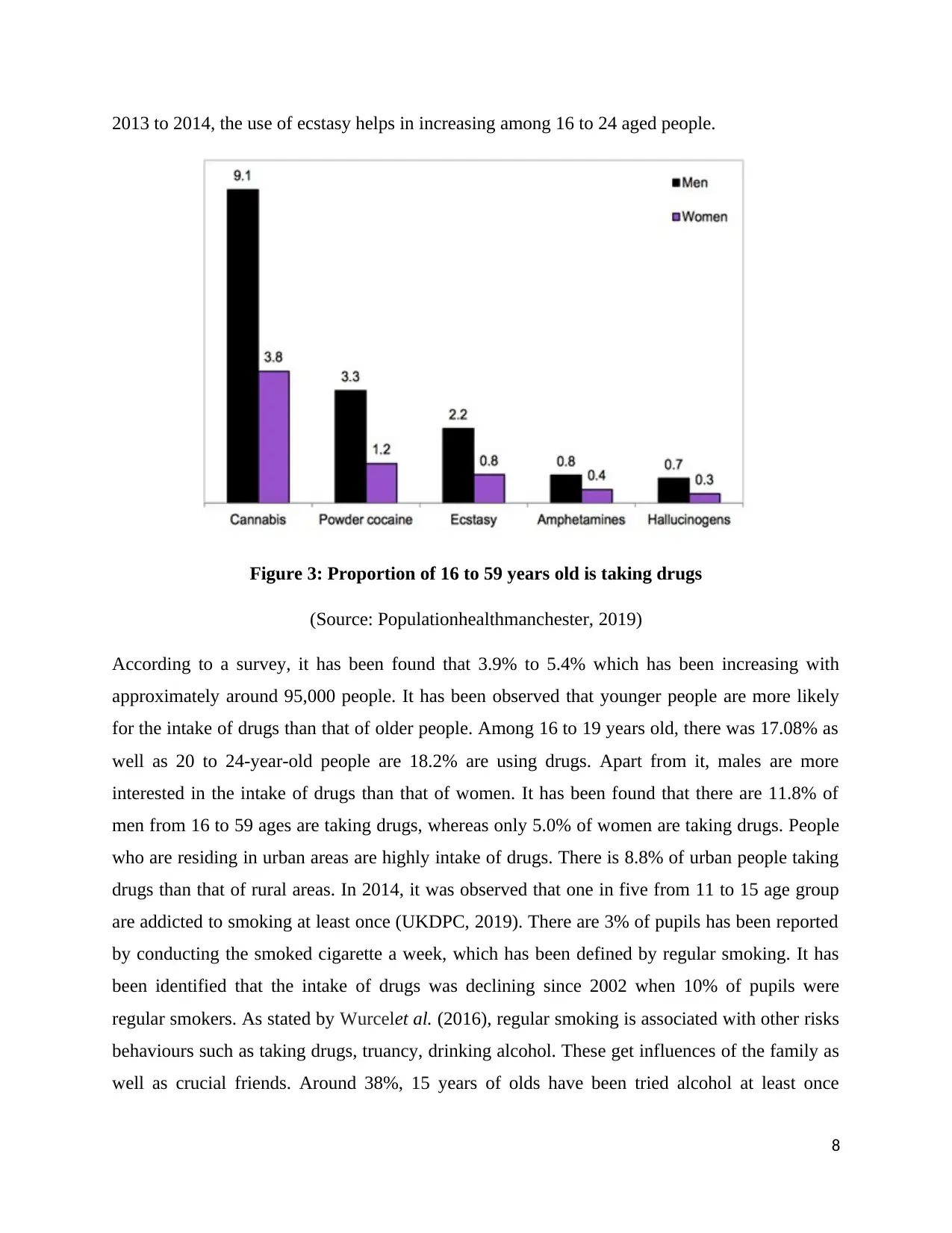
2013 to 2014, the use of ecstasy helps in increasing among 16 to 24 aged people.
Figure 3: Proportion of 16 to 59 years old is taking drugs
(Source: Populationhealthmanchester, 2019)
According to a survey, it has been found that 3.9% to 5.4% which has been increasing with
approximately around 95,000 people. It has been observed that younger people are more likely
for the intake of drugs than that of older people. Among 16 to 19 years old, there was 17.08% as
well as 20 to 24-year-old people are 18.2% are using drugs. Apart from it, males are more
interested in the intake of drugs than that of women. It has been found that there are 11.8% of
men from 16 to 59 ages are taking drugs, whereas only 5.0% of women are taking drugs. People
who are residing in urban areas are highly intake of drugs. There is 8.8% of urban people taking
drugs than that of rural areas. In 2014, it was observed that one in five from 11 to 15 age group
are addicted to smoking at least once (UKDPC, 2019). There are 3% of pupils has been reported
by conducting the smoked cigarette a week, which has been defined by regular smoking. It has
been identified that the intake of drugs was declining since 2002 when 10% of pupils were
regular smokers. As stated by Wurcelet al. (2016), regular smoking is associated with other risks
behaviours such as taking drugs, truancy, drinking alcohol. These get influences of the family as
well as crucial friends. Around 38%, 15 years of olds have been tried alcohol at least once
8
Figure 3: Proportion of 16 to 59 years old is taking drugs
(Source: Populationhealthmanchester, 2019)
According to a survey, it has been found that 3.9% to 5.4% which has been increasing with
approximately around 95,000 people. It has been observed that younger people are more likely
for the intake of drugs than that of older people. Among 16 to 19 years old, there was 17.08% as
well as 20 to 24-year-old people are 18.2% are using drugs. Apart from it, males are more
interested in the intake of drugs than that of women. It has been found that there are 11.8% of
men from 16 to 59 ages are taking drugs, whereas only 5.0% of women are taking drugs. People
who are residing in urban areas are highly intake of drugs. There is 8.8% of urban people taking
drugs than that of rural areas. In 2014, it was observed that one in five from 11 to 15 age group
are addicted to smoking at least once (UKDPC, 2019). There are 3% of pupils has been reported
by conducting the smoked cigarette a week, which has been defined by regular smoking. It has
been identified that the intake of drugs was declining since 2002 when 10% of pupils were
regular smokers. As stated by Wurcelet al. (2016), regular smoking is associated with other risks
behaviours such as taking drugs, truancy, drinking alcohol. These get influences of the family as
well as crucial friends. Around 38%, 15 years of olds have been tried alcohol at least once
8
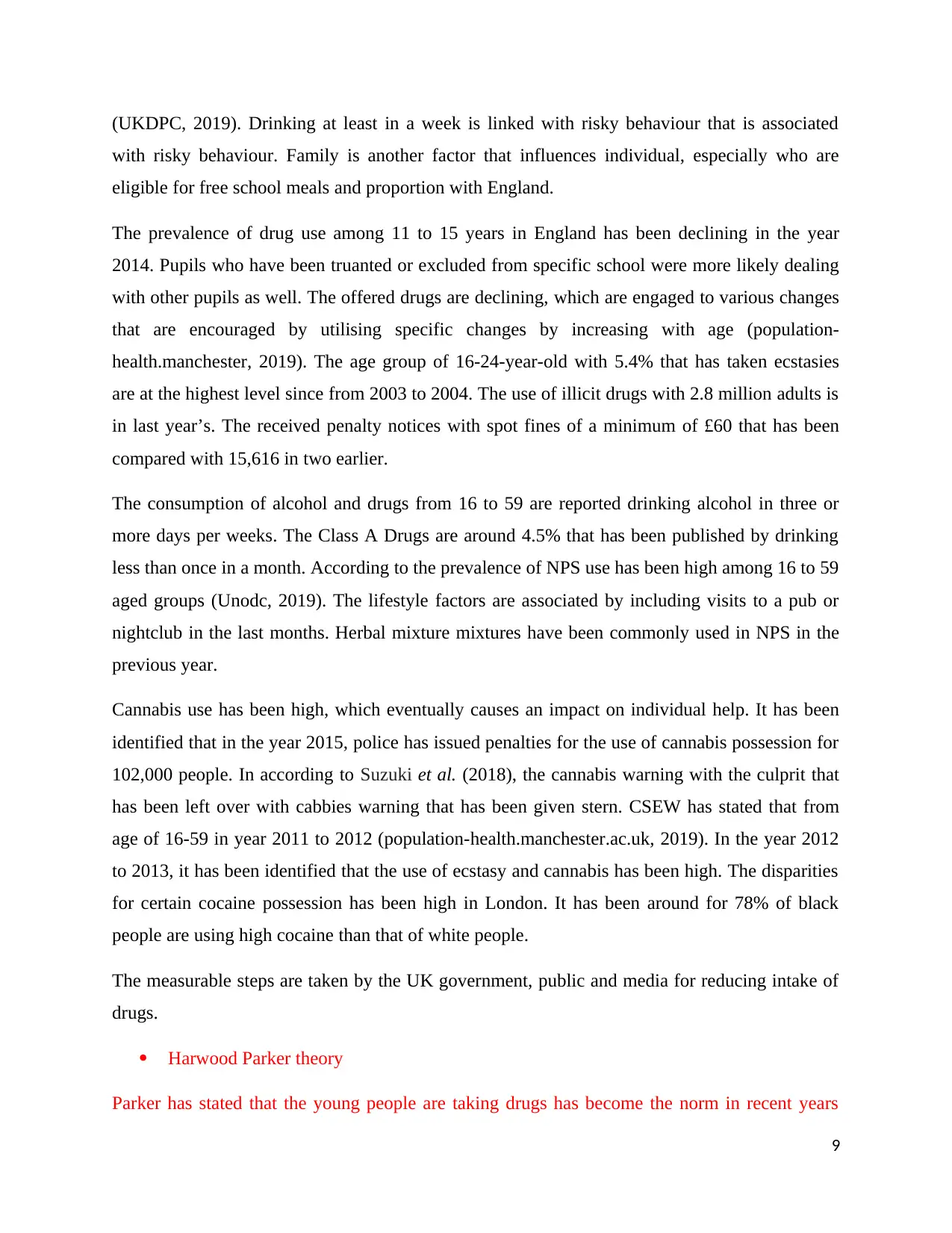
(UKDPC, 2019). Drinking at least in a week is linked with risky behaviour that is associated
with risky behaviour. Family is another factor that influences individual, especially who are
eligible for free school meals and proportion with England.
The prevalence of drug use among 11 to 15 years in England has been declining in the year
2014. Pupils who have been truanted or excluded from specific school were more likely dealing
with other pupils as well. The offered drugs are declining, which are engaged to various changes
that are encouraged by utilising specific changes by increasing with age (population-
health.manchester, 2019). The age group of 16-24-year-old with 5.4% that has taken ecstasies
are at the highest level since from 2003 to 2004. The use of illicit drugs with 2.8 million adults is
in last year’s. The received penalty notices with spot fines of a minimum of £60 that has been
compared with 15,616 in two earlier.
The consumption of alcohol and drugs from 16 to 59 are reported drinking alcohol in three or
more days per weeks. The Class A Drugs are around 4.5% that has been published by drinking
less than once in a month. According to the prevalence of NPS use has been high among 16 to 59
aged groups (Unodc, 2019). The lifestyle factors are associated by including visits to a pub or
nightclub in the last months. Herbal mixture mixtures have been commonly used in NPS in the
previous year.
Cannabis use has been high, which eventually causes an impact on individual help. It has been
identified that in the year 2015, police has issued penalties for the use of cannabis possession for
102,000 people. In according to Suzuki et al. (2018), the cannabis warning with the culprit that
has been left over with cabbies warning that has been given stern. CSEW has stated that from
age of 16-59 in year 2011 to 2012 (population-health.manchester.ac.uk, 2019). In the year 2012
to 2013, it has been identified that the use of ecstasy and cannabis has been high. The disparities
for certain cocaine possession has been high in London. It has been around for 78% of black
people are using high cocaine than that of white people.
The measurable steps are taken by the UK government, public and media for reducing intake of
drugs.
Harwood Parker theory
Parker has stated that the young people are taking drugs has become the norm in recent years
9
with risky behaviour. Family is another factor that influences individual, especially who are
eligible for free school meals and proportion with England.
The prevalence of drug use among 11 to 15 years in England has been declining in the year
2014. Pupils who have been truanted or excluded from specific school were more likely dealing
with other pupils as well. The offered drugs are declining, which are engaged to various changes
that are encouraged by utilising specific changes by increasing with age (population-
health.manchester, 2019). The age group of 16-24-year-old with 5.4% that has taken ecstasies
are at the highest level since from 2003 to 2004. The use of illicit drugs with 2.8 million adults is
in last year’s. The received penalty notices with spot fines of a minimum of £60 that has been
compared with 15,616 in two earlier.
The consumption of alcohol and drugs from 16 to 59 are reported drinking alcohol in three or
more days per weeks. The Class A Drugs are around 4.5% that has been published by drinking
less than once in a month. According to the prevalence of NPS use has been high among 16 to 59
aged groups (Unodc, 2019). The lifestyle factors are associated by including visits to a pub or
nightclub in the last months. Herbal mixture mixtures have been commonly used in NPS in the
previous year.
Cannabis use has been high, which eventually causes an impact on individual help. It has been
identified that in the year 2015, police has issued penalties for the use of cannabis possession for
102,000 people. In according to Suzuki et al. (2018), the cannabis warning with the culprit that
has been left over with cabbies warning that has been given stern. CSEW has stated that from
age of 16-59 in year 2011 to 2012 (population-health.manchester.ac.uk, 2019). In the year 2012
to 2013, it has been identified that the use of ecstasy and cannabis has been high. The disparities
for certain cocaine possession has been high in London. It has been around for 78% of black
people are using high cocaine than that of white people.
The measurable steps are taken by the UK government, public and media for reducing intake of
drugs.
Harwood Parker theory
Parker has stated that the young people are taking drugs has become the norm in recent years
9
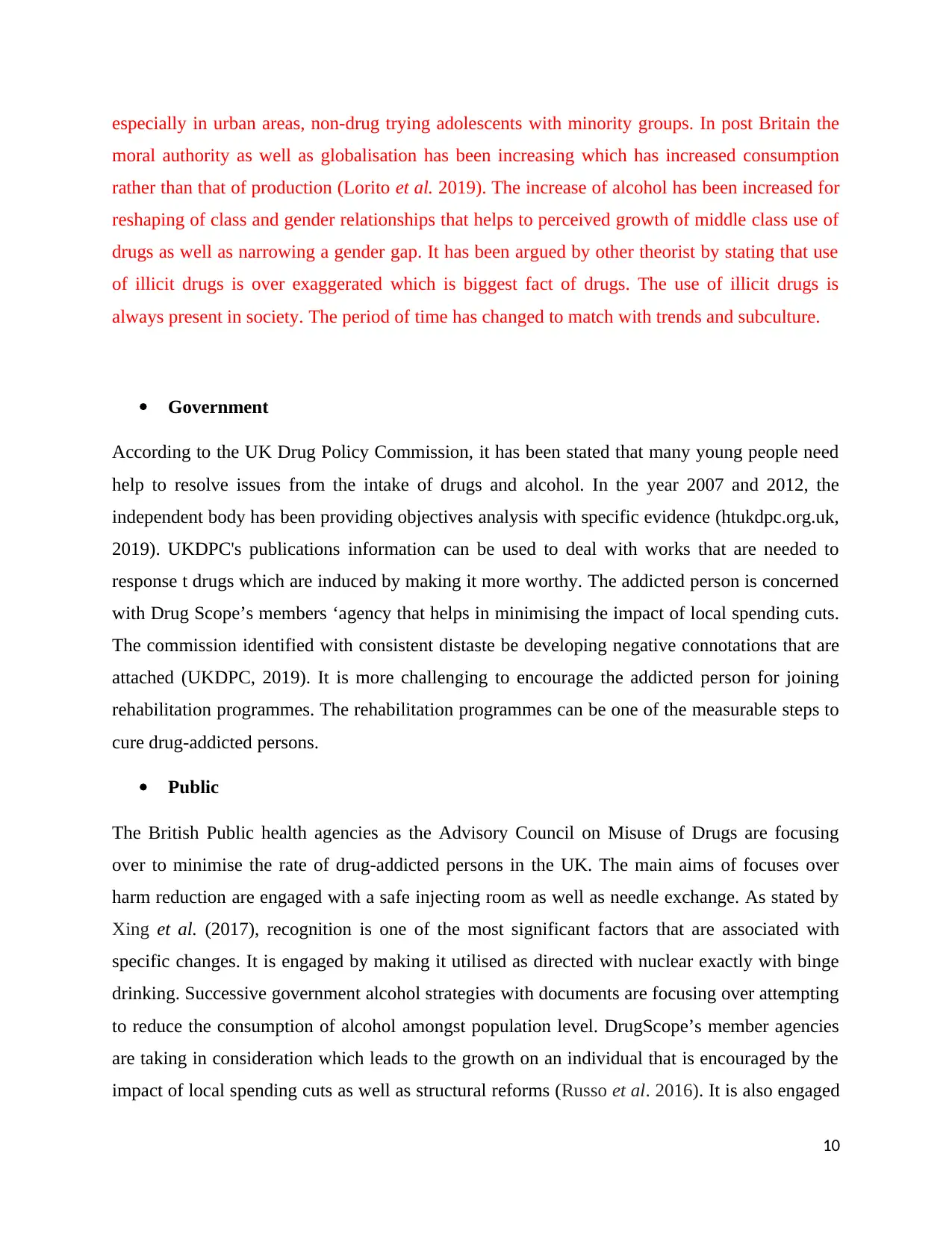
especially in urban areas, non-drug trying adolescents with minority groups. In post Britain the
moral authority as well as globalisation has been increasing which has increased consumption
rather than that of production (Lorito et al. 2019). The increase of alcohol has been increased for
reshaping of class and gender relationships that helps to perceived growth of middle class use of
drugs as well as narrowing a gender gap. It has been argued by other theorist by stating that use
of illicit drugs is over exaggerated which is biggest fact of drugs. The use of illicit drugs is
always present in society. The period of time has changed to match with trends and subculture.
Government
According to the UK Drug Policy Commission, it has been stated that many young people need
help to resolve issues from the intake of drugs and alcohol. In the year 2007 and 2012, the
independent body has been providing objectives analysis with specific evidence (htukdpc.org.uk,
2019). UKDPC's publications information can be used to deal with works that are needed to
response t drugs which are induced by making it more worthy. The addicted person is concerned
with Drug Scope’s members ‘agency that helps in minimising the impact of local spending cuts.
The commission identified with consistent distaste be developing negative connotations that are
attached (UKDPC, 2019). It is more challenging to encourage the addicted person for joining
rehabilitation programmes. The rehabilitation programmes can be one of the measurable steps to
cure drug-addicted persons.
Public
The British Public health agencies as the Advisory Council on Misuse of Drugs are focusing
over to minimise the rate of drug-addicted persons in the UK. The main aims of focuses over
harm reduction are engaged with a safe injecting room as well as needle exchange. As stated by
Xing et al. (2017), recognition is one of the most significant factors that are associated with
specific changes. It is engaged by making it utilised as directed with nuclear exactly with binge
drinking. Successive government alcohol strategies with documents are focusing over attempting
to reduce the consumption of alcohol amongst population level. DrugScope’s member agencies
are taking in consideration which leads to the growth on an individual that is encouraged by the
impact of local spending cuts as well as structural reforms (Russo et al. 2016). It is also engaged
10
moral authority as well as globalisation has been increasing which has increased consumption
rather than that of production (Lorito et al. 2019). The increase of alcohol has been increased for
reshaping of class and gender relationships that helps to perceived growth of middle class use of
drugs as well as narrowing a gender gap. It has been argued by other theorist by stating that use
of illicit drugs is over exaggerated which is biggest fact of drugs. The use of illicit drugs is
always present in society. The period of time has changed to match with trends and subculture.
Government
According to the UK Drug Policy Commission, it has been stated that many young people need
help to resolve issues from the intake of drugs and alcohol. In the year 2007 and 2012, the
independent body has been providing objectives analysis with specific evidence (htukdpc.org.uk,
2019). UKDPC's publications information can be used to deal with works that are needed to
response t drugs which are induced by making it more worthy. The addicted person is concerned
with Drug Scope’s members ‘agency that helps in minimising the impact of local spending cuts.
The commission identified with consistent distaste be developing negative connotations that are
attached (UKDPC, 2019). It is more challenging to encourage the addicted person for joining
rehabilitation programmes. The rehabilitation programmes can be one of the measurable steps to
cure drug-addicted persons.
Public
The British Public health agencies as the Advisory Council on Misuse of Drugs are focusing
over to minimise the rate of drug-addicted persons in the UK. The main aims of focuses over
harm reduction are engaged with a safe injecting room as well as needle exchange. As stated by
Xing et al. (2017), recognition is one of the most significant factors that are associated with
specific changes. It is engaged by making it utilised as directed with nuclear exactly with binge
drinking. Successive government alcohol strategies with documents are focusing over attempting
to reduce the consumption of alcohol amongst population level. DrugScope’s member agencies
are taking in consideration which leads to the growth on an individual that is encouraged by the
impact of local spending cuts as well as structural reforms (Russo et al. 2016). It is also engaged
10
Secure Best Marks with AI Grader
Need help grading? Try our AI Grader for instant feedback on your assignments.
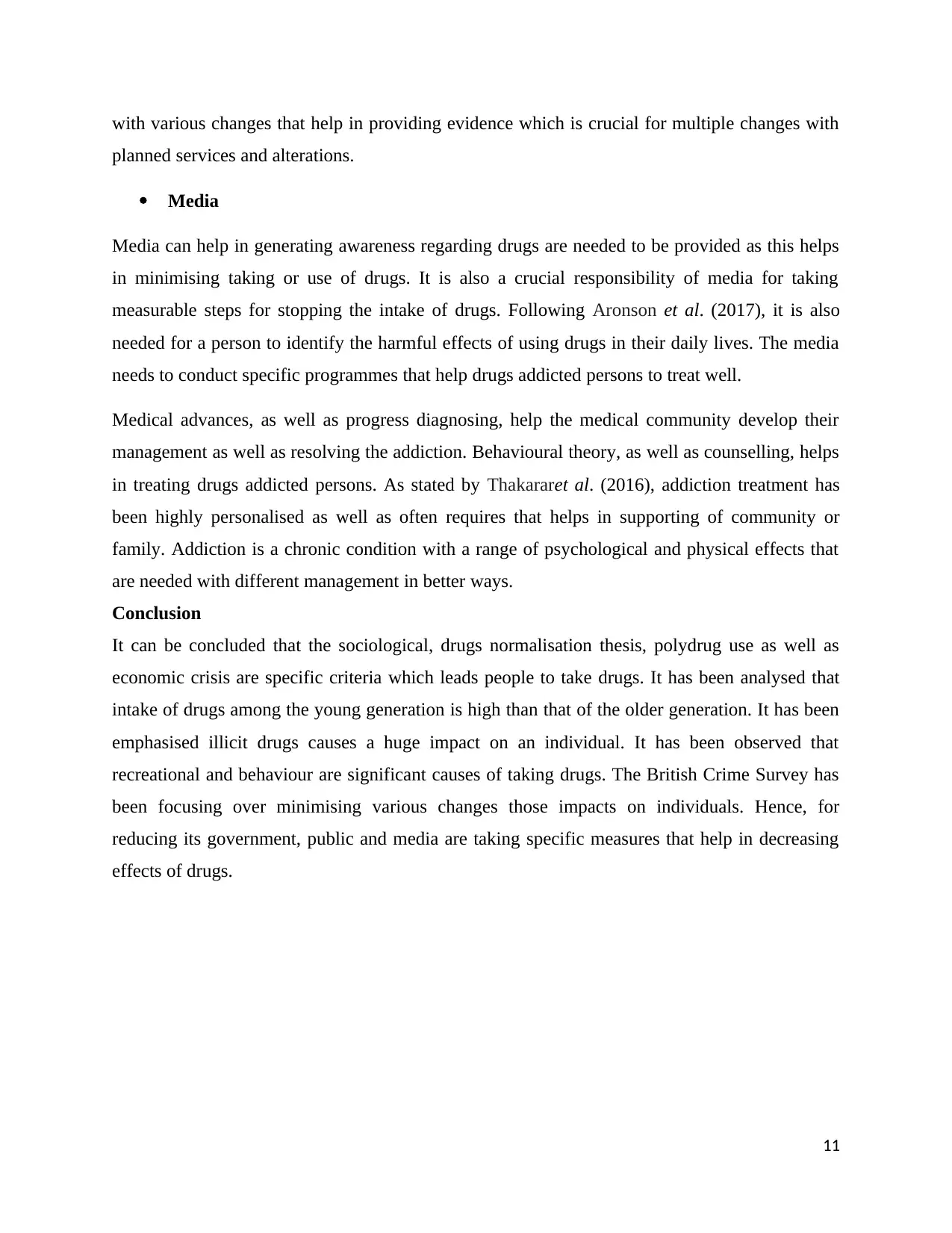
with various changes that help in providing evidence which is crucial for multiple changes with
planned services and alterations.
Media
Media can help in generating awareness regarding drugs are needed to be provided as this helps
in minimising taking or use of drugs. It is also a crucial responsibility of media for taking
measurable steps for stopping the intake of drugs. Following Aronson et al. (2017), it is also
needed for a person to identify the harmful effects of using drugs in their daily lives. The media
needs to conduct specific programmes that help drugs addicted persons to treat well.
Medical advances, as well as progress diagnosing, help the medical community develop their
management as well as resolving the addiction. Behavioural theory, as well as counselling, helps
in treating drugs addicted persons. As stated by Thakararet al. (2016), addiction treatment has
been highly personalised as well as often requires that helps in supporting of community or
family. Addiction is a chronic condition with a range of psychological and physical effects that
are needed with different management in better ways.
Conclusion
It can be concluded that the sociological, drugs normalisation thesis, polydrug use as well as
economic crisis are specific criteria which leads people to take drugs. It has been analysed that
intake of drugs among the young generation is high than that of the older generation. It has been
emphasised illicit drugs causes a huge impact on an individual. It has been observed that
recreational and behaviour are significant causes of taking drugs. The British Crime Survey has
been focusing over minimising various changes those impacts on individuals. Hence, for
reducing its government, public and media are taking specific measures that help in decreasing
effects of drugs.
11
planned services and alterations.
Media
Media can help in generating awareness regarding drugs are needed to be provided as this helps
in minimising taking or use of drugs. It is also a crucial responsibility of media for taking
measurable steps for stopping the intake of drugs. Following Aronson et al. (2017), it is also
needed for a person to identify the harmful effects of using drugs in their daily lives. The media
needs to conduct specific programmes that help drugs addicted persons to treat well.
Medical advances, as well as progress diagnosing, help the medical community develop their
management as well as resolving the addiction. Behavioural theory, as well as counselling, helps
in treating drugs addicted persons. As stated by Thakararet al. (2016), addiction treatment has
been highly personalised as well as often requires that helps in supporting of community or
family. Addiction is a chronic condition with a range of psychological and physical effects that
are needed with different management in better ways.
Conclusion
It can be concluded that the sociological, drugs normalisation thesis, polydrug use as well as
economic crisis are specific criteria which leads people to take drugs. It has been analysed that
intake of drugs among the young generation is high than that of the older generation. It has been
emphasised illicit drugs causes a huge impact on an individual. It has been observed that
recreational and behaviour are significant causes of taking drugs. The British Crime Survey has
been focusing over minimising various changes those impacts on individuals. Hence, for
reducing its government, public and media are taking specific measures that help in decreasing
effects of drugs.
11
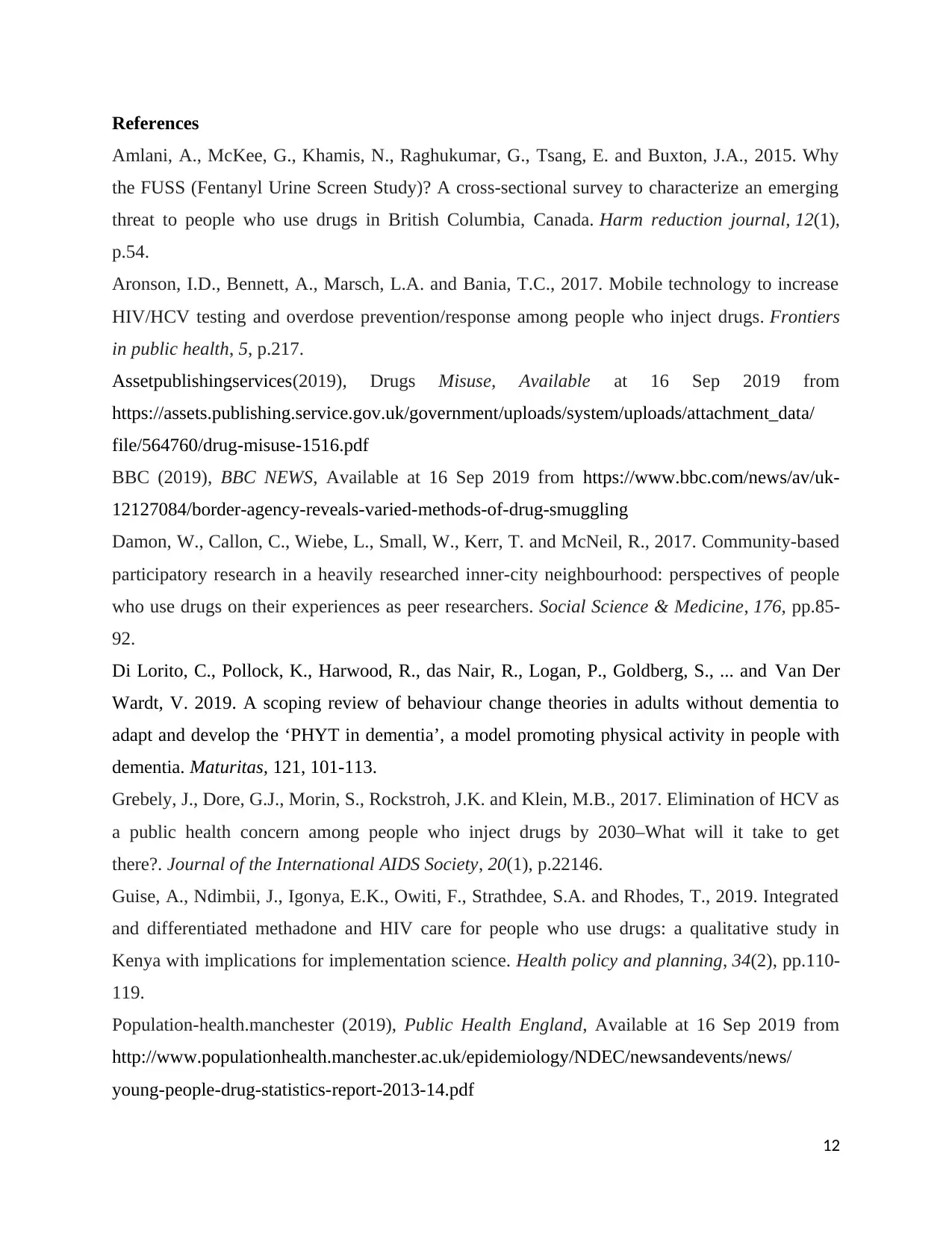
References
Amlani, A., McKee, G., Khamis, N., Raghukumar, G., Tsang, E. and Buxton, J.A., 2015. Why
the FUSS (Fentanyl Urine Screen Study)? A cross-sectional survey to characterize an emerging
threat to people who use drugs in British Columbia, Canada. Harm reduction journal, 12(1),
p.54.
Aronson, I.D., Bennett, A., Marsch, L.A. and Bania, T.C., 2017. Mobile technology to increase
HIV/HCV testing and overdose prevention/response among people who inject drugs. Frontiers
in public health, 5, p.217.
Assetpublishingservices(2019), Drugs Misuse, Available at 16 Sep 2019 from
https://assets.publishing.service.gov.uk/government/uploads/system/uploads/attachment_data/
file/564760/drug-misuse-1516.pdf
BBC (2019), BBC NEWS, Available at 16 Sep 2019 from https://www.bbc.com/news/av/uk-
12127084/border-agency-reveals-varied-methods-of-drug-smuggling
Damon, W., Callon, C., Wiebe, L., Small, W., Kerr, T. and McNeil, R., 2017. Community-based
participatory research in a heavily researched inner-city neighbourhood: perspectives of people
who use drugs on their experiences as peer researchers. Social Science & Medicine, 176, pp.85-
92.
Di Lorito, C., Pollock, K., Harwood, R., das Nair, R., Logan, P., Goldberg, S., ... and Van Der
Wardt, V. 2019. A scoping review of behaviour change theories in adults without dementia to
adapt and develop the ‘PHYT in dementia’, a model promoting physical activity in people with
dementia. Maturitas, 121, 101-113.
Grebely, J., Dore, G.J., Morin, S., Rockstroh, J.K. and Klein, M.B., 2017. Elimination of HCV as
a public health concern among people who inject drugs by 2030–What will it take to get
there?. Journal of the International AIDS Society, 20(1), p.22146.
Guise, A., Ndimbii, J., Igonya, E.K., Owiti, F., Strathdee, S.A. and Rhodes, T., 2019. Integrated
and differentiated methadone and HIV care for people who use drugs: a qualitative study in
Kenya with implications for implementation science. Health policy and planning, 34(2), pp.110-
119.
Population-health.manchester (2019), Public Health England, Available at 16 Sep 2019 from
http://www.populationhealth.manchester.ac.uk/epidemiology/NDEC/newsandevents/news/
young-people-drug-statistics-report-2013-14.pdf
12
Amlani, A., McKee, G., Khamis, N., Raghukumar, G., Tsang, E. and Buxton, J.A., 2015. Why
the FUSS (Fentanyl Urine Screen Study)? A cross-sectional survey to characterize an emerging
threat to people who use drugs in British Columbia, Canada. Harm reduction journal, 12(1),
p.54.
Aronson, I.D., Bennett, A., Marsch, L.A. and Bania, T.C., 2017. Mobile technology to increase
HIV/HCV testing and overdose prevention/response among people who inject drugs. Frontiers
in public health, 5, p.217.
Assetpublishingservices(2019), Drugs Misuse, Available at 16 Sep 2019 from
https://assets.publishing.service.gov.uk/government/uploads/system/uploads/attachment_data/
file/564760/drug-misuse-1516.pdf
BBC (2019), BBC NEWS, Available at 16 Sep 2019 from https://www.bbc.com/news/av/uk-
12127084/border-agency-reveals-varied-methods-of-drug-smuggling
Damon, W., Callon, C., Wiebe, L., Small, W., Kerr, T. and McNeil, R., 2017. Community-based
participatory research in a heavily researched inner-city neighbourhood: perspectives of people
who use drugs on their experiences as peer researchers. Social Science & Medicine, 176, pp.85-
92.
Di Lorito, C., Pollock, K., Harwood, R., das Nair, R., Logan, P., Goldberg, S., ... and Van Der
Wardt, V. 2019. A scoping review of behaviour change theories in adults without dementia to
adapt and develop the ‘PHYT in dementia’, a model promoting physical activity in people with
dementia. Maturitas, 121, 101-113.
Grebely, J., Dore, G.J., Morin, S., Rockstroh, J.K. and Klein, M.B., 2017. Elimination of HCV as
a public health concern among people who inject drugs by 2030–What will it take to get
there?. Journal of the International AIDS Society, 20(1), p.22146.
Guise, A., Ndimbii, J., Igonya, E.K., Owiti, F., Strathdee, S.A. and Rhodes, T., 2019. Integrated
and differentiated methadone and HIV care for people who use drugs: a qualitative study in
Kenya with implications for implementation science. Health policy and planning, 34(2), pp.110-
119.
Population-health.manchester (2019), Public Health England, Available at 16 Sep 2019 from
http://www.populationhealth.manchester.ac.uk/epidemiology/NDEC/newsandevents/news/
young-people-drug-statistics-report-2013-14.pdf
12
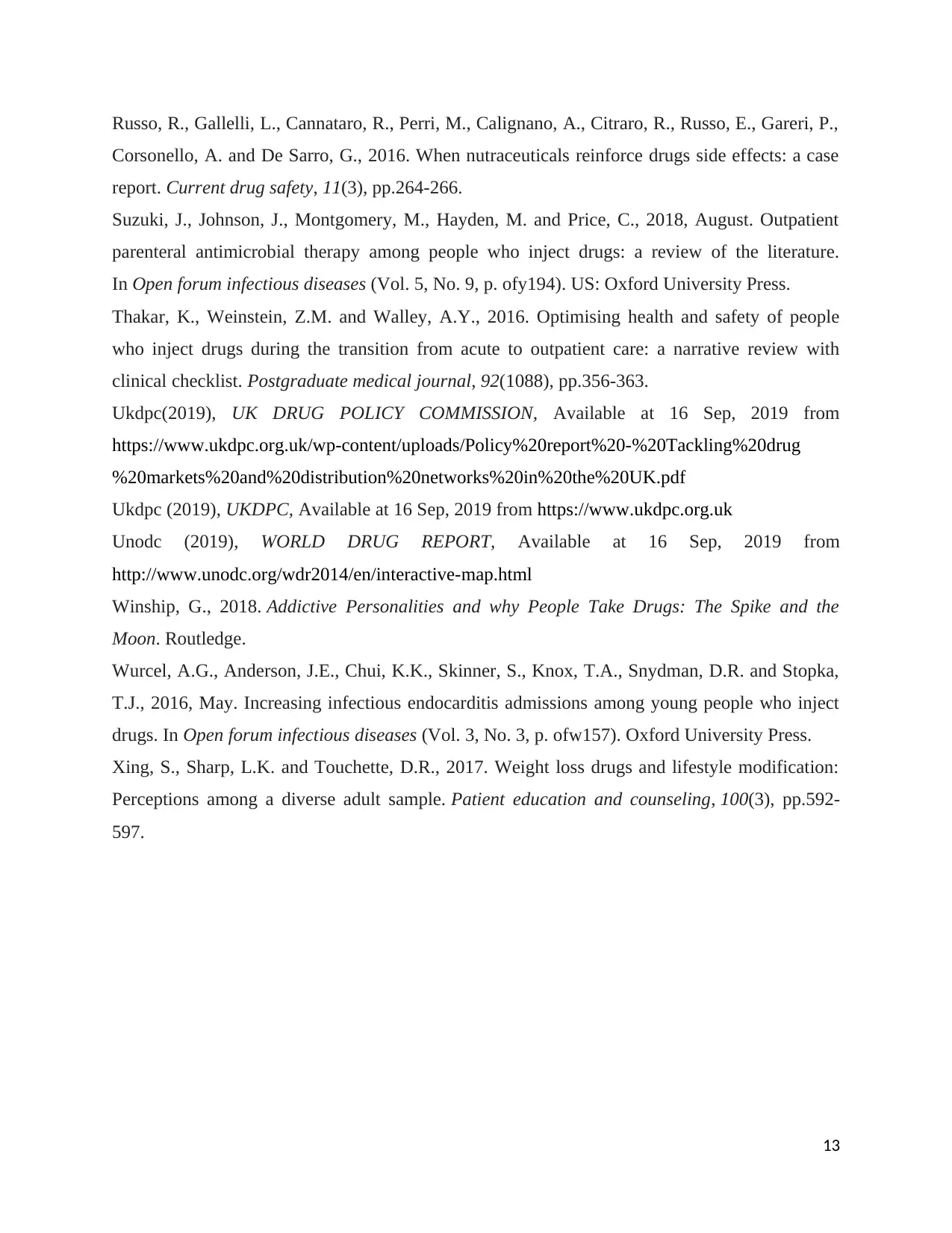
Russo, R., Gallelli, L., Cannataro, R., Perri, M., Calignano, A., Citraro, R., Russo, E., Gareri, P.,
Corsonello, A. and De Sarro, G., 2016. When nutraceuticals reinforce drugs side effects: a case
report. Current drug safety, 11(3), pp.264-266.
Suzuki, J., Johnson, J., Montgomery, M., Hayden, M. and Price, C., 2018, August. Outpatient
parenteral antimicrobial therapy among people who inject drugs: a review of the literature.
In Open forum infectious diseases (Vol. 5, No. 9, p. ofy194). US: Oxford University Press.
Thakar, K., Weinstein, Z.M. and Walley, A.Y., 2016. Optimising health and safety of people
who inject drugs during the transition from acute to outpatient care: a narrative review with
clinical checklist. Postgraduate medical journal, 92(1088), pp.356-363.
Ukdpc(2019), UK DRUG POLICY COMMISSION, Available at 16 Sep, 2019 from
https://www.ukdpc.org.uk/wp-content/uploads/Policy%20report%20-%20Tackling%20drug
%20markets%20and%20distribution%20networks%20in%20the%20UK.pdf
Ukdpc (2019), UKDPC, Available at 16 Sep, 2019 from https://www.ukdpc.org.uk
Unodc (2019), WORLD DRUG REPORT, Available at 16 Sep, 2019 from
http://www.unodc.org/wdr2014/en/interactive-map.html
Winship, G., 2018. Addictive Personalities and why People Take Drugs: The Spike and the
Moon. Routledge.
Wurcel, A.G., Anderson, J.E., Chui, K.K., Skinner, S., Knox, T.A., Snydman, D.R. and Stopka,
T.J., 2016, May. Increasing infectious endocarditis admissions among young people who inject
drugs. In Open forum infectious diseases (Vol. 3, No. 3, p. ofw157). Oxford University Press.
Xing, S., Sharp, L.K. and Touchette, D.R., 2017. Weight loss drugs and lifestyle modification:
Perceptions among a diverse adult sample. Patient education and counseling, 100(3), pp.592-
597.
13
Corsonello, A. and De Sarro, G., 2016. When nutraceuticals reinforce drugs side effects: a case
report. Current drug safety, 11(3), pp.264-266.
Suzuki, J., Johnson, J., Montgomery, M., Hayden, M. and Price, C., 2018, August. Outpatient
parenteral antimicrobial therapy among people who inject drugs: a review of the literature.
In Open forum infectious diseases (Vol. 5, No. 9, p. ofy194). US: Oxford University Press.
Thakar, K., Weinstein, Z.M. and Walley, A.Y., 2016. Optimising health and safety of people
who inject drugs during the transition from acute to outpatient care: a narrative review with
clinical checklist. Postgraduate medical journal, 92(1088), pp.356-363.
Ukdpc(2019), UK DRUG POLICY COMMISSION, Available at 16 Sep, 2019 from
https://www.ukdpc.org.uk/wp-content/uploads/Policy%20report%20-%20Tackling%20drug
%20markets%20and%20distribution%20networks%20in%20the%20UK.pdf
Ukdpc (2019), UKDPC, Available at 16 Sep, 2019 from https://www.ukdpc.org.uk
Unodc (2019), WORLD DRUG REPORT, Available at 16 Sep, 2019 from
http://www.unodc.org/wdr2014/en/interactive-map.html
Winship, G., 2018. Addictive Personalities and why People Take Drugs: The Spike and the
Moon. Routledge.
Wurcel, A.G., Anderson, J.E., Chui, K.K., Skinner, S., Knox, T.A., Snydman, D.R. and Stopka,
T.J., 2016, May. Increasing infectious endocarditis admissions among young people who inject
drugs. In Open forum infectious diseases (Vol. 3, No. 3, p. ofw157). Oxford University Press.
Xing, S., Sharp, L.K. and Touchette, D.R., 2017. Weight loss drugs and lifestyle modification:
Perceptions among a diverse adult sample. Patient education and counseling, 100(3), pp.592-
597.
13
1 out of 13
Related Documents
Your All-in-One AI-Powered Toolkit for Academic Success.
+13062052269
info@desklib.com
Available 24*7 on WhatsApp / Email
![[object Object]](/_next/static/media/star-bottom.7253800d.svg)
Unlock your academic potential
© 2024 | Zucol Services PVT LTD | All rights reserved.





